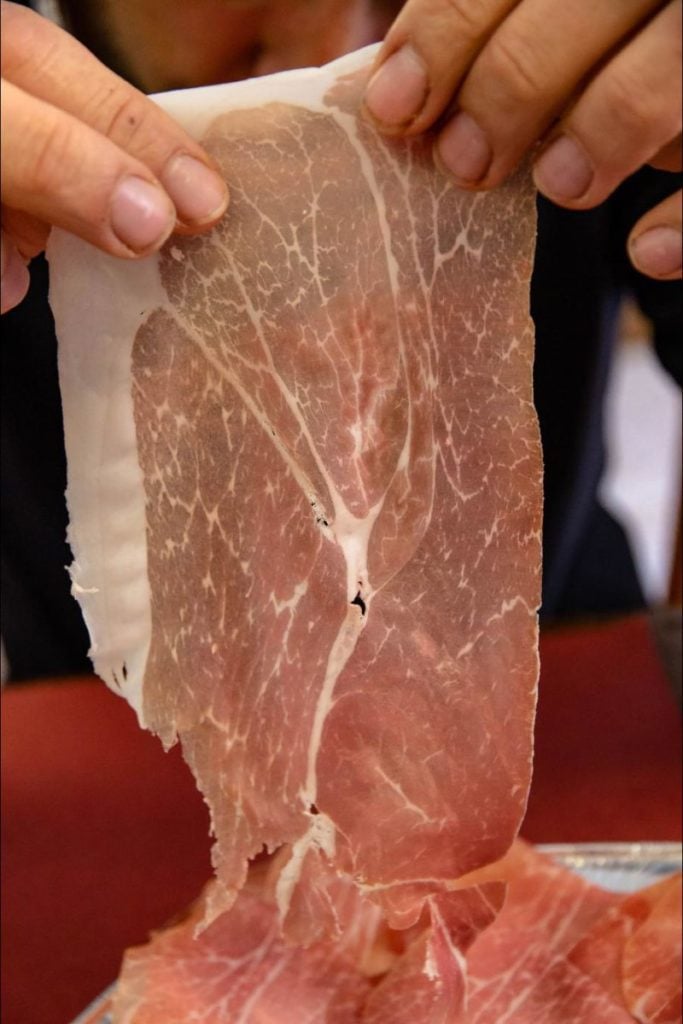Prosciutto can go bad — even though it’s cured and dried, it’s still pork at its core. How quickly that happens depends on how it’s stored, its form (sliced or whole), and how long it has been exposed to oxygen.
Over the years of making, slicing, and aging prosciutto myself, I’ve picked up a few key insights on how to keep it fresher for longer, and more importantly, how to know when it’s no longer safe to eat.
I’ve been making and eating prosciutto and other cured meats for decades. Since it’s a salt-cured product, people often assume it lasts forever.
However, like any preserved meat, it has its limits. Whether it’s sliced at the deli or a full leg drying in your curing chamber, prosciutto will eventually dry out, lose quality, or spoil.
Prosciutto is iconic — one of Italy’s most well-known cured meats, found on charcuterie boards, folded onto pizza, or draped over melon. The rich, salty-sweet flavor comes from long drying times, typically 12–36 months, and the simplicity of pork and salt. But even this age-old preservation method doesn’t make it immune to decay.
While it won’t “go bad” as quickly as raw meat, prosciutto can still spoil or become so dry it’s unpleasant to eat. Even if it’s past its expiration date, it might still be safe — or it could be a food safety risk. The key is understanding the different forms of prosciutto and their storage limits.
Whole prosciutto lasts much longer than sliced prosciutto. Once it’s cut, the meat is more exposed to oxygen and moisture, which accelerates the spoilage process. On the other hand, a sealed whole leg can last many months — even years.
From my experiments, I’ve found that vacuum-sealed prosciutto, whether in chunk or whole-muscle form, can stay in the fridge for up to two or three years without any significant issues. Once opened, though, it’s a different story — the clock starts ticking quickly once air hits the meat.
That’s the advantage of a vacpac, because I can then re-seal the cured meat and put it back in th fridge.
Here’s a breakdown of what to expect when it comes to shelf life and storage:
- Sliced Prosciutto: Lasts 5–7 days in the fridge. Thin slices dry out fast and have a lot of surface area, making them more vulnerable to bacteria and oxidation.
- Whole Prosciutto (Unopened): Can last up to 12 months or longer, if vacuum-sealed with the skin intact. In cool conditions, it’s ideal. A fridge runs very dry and can quicken the drying process, reducing shelf life (especially with dry-cured meat, which often loses the ideal amount of moisture already).
- Frozen Prosciutto: Freezing isn’t ideal and affects texture and flavor. Still, frozen prosciutto can last months or years.
I’ve vacuum-packed all my home-cured whole-muscle meats using reusable sous vide bags, and I’ve easily gone over a year without any spoilage (this means I’m not wasting vac-sealed bags each time I open one).
The key is avoiding light, moisture, and oxygen — the main enemies of long-term storage. I usually wrap the bag in brown paper to keep light off it inside the fridge.
One time, a mate of mine brought frozen prosciutto to camp on a hunting trip. He didn’t even realize it was a dry-cured product — just thawed it out and started slicing. It was fine, though the texture had suffered slightly. That showed me how forgiving it can be if it’s been properly handled from the start.
Proper storage makes all the difference. But even under ideal conditions, prosciutto won’t last forever. Eventually, it dries out to a point where it becomes leathery or crumbly, losing its signature melt-in-the-mouth texture. Or worse, it could spoil due to bacterial activity.
And when in doubt? Trust your senses — and your gut. If it smells off, looks strange, or tastes sour, toss it. Better to lose a few slices than end up with a case of food poisoning.
Prosciutto may be preserved, but it’s still meat — and like any meat, it will eventually spoil. The main causes of spoilage are exposure to air, temperature fluctuations, and high humidity. Even in a sealed fridge, oxidation and bacteria can slowly do their work over time.

How It Spoils & Signs It Has Gone Bad
From my own experience, the most common reason prosciutto becomes inedible isn’t rot — it’s dehydration. When it dries out too far, the texture becomes tough and crumbly, and the fat oxidizes. You’re left with something chewy and bland, instead of that melt-in-your-mouth feel prosciutto is known for.
But spoilage can go beyond dryness. Like any food, there are clear signs that tell you it’s time to throw it out. Here’s what to look for:
- Color Changes: Healthy prosciutto should have a pink to red hue with creamy white fat. If it turns gray, green, or develops fuzzy spots, it’s no longer safe to eat. (Source: eHow)
- Unpleasant Smell: You should smell sweetness and saltiness, not sourness, ammonia, or anything funky. If you’re catching bitter, tangy, or sharp smells, trust your nose and bin it.
- Texture or Moisture: If it’s slimy or wet when it should be dry and firm, that’s a big red flag. Too dry? It’s not unsafe, but it won’t be enjoyable either.
It might be tempting to taste a little to check — but I strongly advise against it. Even a small amount of spoiled pork can cause serious food poisoning. It’s not worth the risk.
Storage Methods to Keep Prosciutto Fresher
So, how do you keep prosciutto at its best for as long as possible? It depends on whether it’s sliced or whole, opened or sealed.
For sliced prosciutto, wrap it tightly in parchment or wax paper, then place it in a resealable container or vacuum bag. Don’t use cling film — it can make the fat go rancid faster. Keep it in the coldest part of your fridge, ideally below 4°C (40°F).
If you’re storing a large whole muscle or a chunk of prosciutto, vacuum sealing is ideal. I’ve had pieces last over two years this way. I always wrap them in brown paper to block light and then vacuum pack in reusable sous vide bags. The flavor actually deepens over time, and the fat remains creamy.
Just remember, vacuum sealing is a form of storage, not a replacement for actual curing. For anyone curious about how salt plays into preservation, I’ve also covered the difference between Himalayan salt vs pink curing salt — an important distinction when it comes to food safety vs. flavor.
If you’re dealing with high-end Italian prosciutto like Prosciutto di Parma, you’ll want to treat it right. These carefully aged hams aren’t cheap — and for good reason. I’ve broken down exactly why Prosciutto di Parma is worth the money in a separate article if you’re curious about what sets it apart from basic supermarket options.

And if the worst happens and your prosciutto does go off, don’t stress. There are excellent options out there for replacements, whether you’re building a charcuterie board or cooking with it.
I wrote a full guide on what is a good substitute for prosciutto.
Expert Tips from My Own Experience
After decades of making and storing cured meats, I’ve learned a few practical tricks to make prosciutto last longer — while keeping its texture and flavor intact.
- Wrap it smart: For sliced prosciutto, opt for parchment paper instead of plastic wrap. Instead, use baking paper or wax paper inside a container. This keeps the fat from oxidizing and turning rancid.
- Control light and temperature: Store prosciutto in the fridge, ideally in a drawer or wrapped in brown paper to block light. Consistent cold temps slow down spoilage dramatically.
- Vacuum seal whole cuts: If you’ve got a chunk or whole piece, vacuum seal it. Mine have lasted up to 2 years this way. Just make sure there’s no moisture or air in the bag before sealing. And if you’re using reusable sous vide bags instead of disposable plastics — even better for the environment.
- Don’t freeze unless necessary: Freezing affects the delicate texture. I only freeze prosciutto if I know it’s going to be used in cooked dishes, like pasta or soups.
As a rule of thumb, I always smell and visually inspect every piece before slicing or serving. Even a beautiful cut can go off if it’s been forgotten in the fridge or improperly sealed. Common sense goes a long way — and when in doubt, throw it out.
FAQ
Can prosciutto be left out at room temperature?
Not for long. Sliced prosciutto should only be left out for up to 2 hours. Whole pieces can last longer if the environment is cool and dry, but refrigeration is always safest.
Is white mold on prosciutto normal?
Yes — on whole, traditionally aged prosciutto, white mold is harmless and often encouraged. It protects the meat. However, if mold appears on sliced prosciutto, it’s best to discard it.
Can I eat prosciutto past its expiration date?
Possibly. Check the smell, texture, and color. If it still looks and smells normal, it may be fine. But if you notice any sourness, slime, or discoloration, don’t take the risk.
Have a question or your own prosciutto storage tip? Let me know in the comments — I always enjoy hearing what others are trying.

Tom Mueller
For decades, immersed in studying, working, learning, and teaching the craft of meat curing, sharing the passion and showcasing the world of charcuterie and smoked meat. Read More
